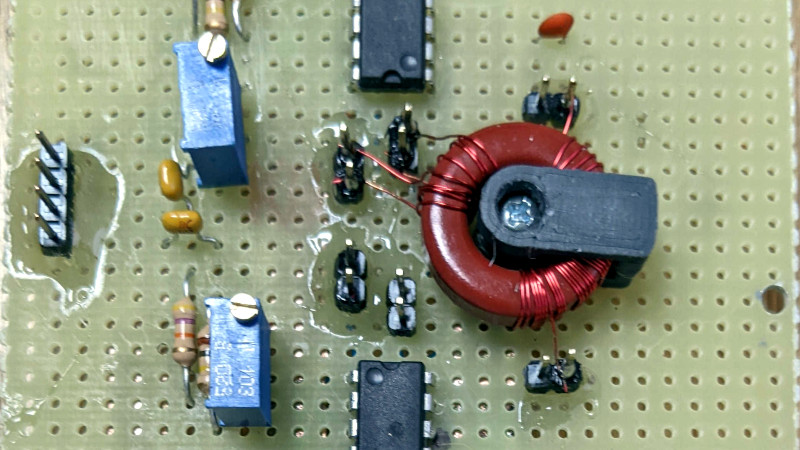Over the years the humble 555 timer has been used in so many unexpected places, but there’s a project from [Frank Latos] which we think may be a first. On a piece of stripboard sit a pair of 555s, and instead of the usual passives there are a set of LC circuits. This is no timer, instead it’s a CW (Morse) transmitter for the 80 metre amateur radio band.
One 555 is configured as a feedback oscillator through a toroidal transformer with a tuned circuit to set the frequency of oscillation. The other takes an inverted input from the oscillator to produce complimentary push-pull outputs from both 555s, which are fed to another transformer that in turn feeds a low-pass filter and thus the antenna.
Free-running squarewave oscillators of this type are not unusual for the lower HF bands, but we think this is the first 555 design we’ve seen. As shown it doesn’t produce much in the way of RF power, but remembering half-decent motor drivers using a 556 dual timer we think that selection of one of the more powerful 555 variants might deliver some more punch. We commend his creativity though, and hope he can get that all-important entry in the log to prove it works.
If you’re curious about low-power radio operation, it’s something we’ve explored before.
















I might remember reading about a 555 used as a radio receiver…
Here you go: https://www.youtube.com/watch?v=KLgY7GhvMn4&ab_channel=stoneslice
I thinkthere was so ething in Popular Electronics in the seventies, but maybe I’m not remembering properly.
When the LM3909 came out, it was loaded with suggested applications, so there might have been a radio there.
I’m new to electronic components, how can I learn about the different components so I can eventually make prototypes and such?
Become an electrical engineer.
Complimentary or complementary output?
Depends on how flattering your 555 is.
It’s not anyway. The two open collectors are 180 degrees out of phase in an interesting way. The end drive would look like rectified AC with each 555 providing half the wave and that’s how he is getting 3.4 – 4MHz out of a chip rated at 3MHz. So in the end it all comes down to the filtering but I would expect there is a low that it out of band.
Good stunt.
Though nominally in violation of the rules:
DOC RBR-4 “12.2 The frequency stability of an amateur station in a frequency band below 148.000 MHz shall be equal to or greater than that which is obtainable using crystal control.”
Since those bands propagate globally, I’m sure there are similar rules in most jurisdictions.
Though, homebuilt with that kind of power output, it might just fall under any of several sections of 47 CFR 15 (FCC “Part 15”).
An LC oscillator in itself is okay. It just has to be stable, and often work is involved to get to that point. That sort of rule came in about the thirties. Too many unstable oscillators, people not taking proper care. So the rise of crystal control, much easier to get stable results, even if you lose frequency flexibility.
I have doubts about this. Sure, there’s a novelty, but what happens when others see a simoke circuit, and plunge in? A single transistor with buffering will give you a stable oscillator, and it’s not trying to stretch a device beyond its normal range. But voltage regulation, good choice of oscillator, good LC ratio, coupling to that tuned curcuit, even temperature compensation, help to make it “stable like a crystal”
It might perhaps be in violation of Canadian rules, although my reading of that clause would suggest that it only applies to AM, and the transmitter in the article is intended for CW-only.
It’s also operating at low enough power that it might actually end up falling outside any “intentional radiator” rules in the first place.
I think I’ve seen designs for Lowfer and <9KHz transmitters using the 555. I'm not sure about ham bands although now there's the 2200 meter band.
If you wanna go retro go retro. Use a rotary spark gap. With an output tank probably not much nosier. Really guys the 555 is 50 years old this year. Time to let it go. There are better ways of doing almost anything it could do. Like you don’t see a lot of people screwing around with 741’s anymore either. Op amps yes, 741’s not so much.
Still see people using 38999.s 4cx250B’s and air spaced variable capacitors etc etc etc. Come to think of it all of my radios still have at least 1 knob on the front, how retro is that?
Have you considered that the fact its still common 50+ years after it was introduced might indicate that its a good basic design, your thinking of it as a microcontroller vs the clever pile of basic parts it actually is. Sometimes there’s performance in simplicity